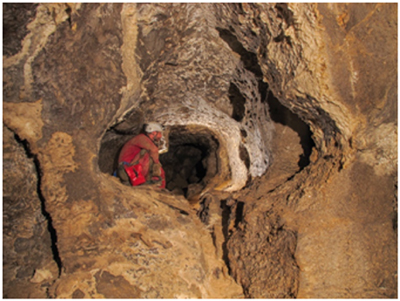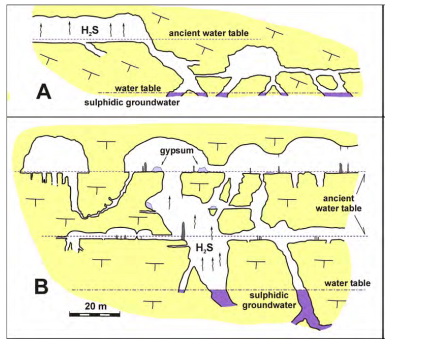Hypogene Caves in Matienzo?
Introduction
In summer 2018, Dimitri Laurent from the University of Lorraine-Nancy visited BigMat Calf Hole (site 3916) to study the passage shapes in Ed's Birthday Passage and take samples of the gypsum. His hypothesis is that this passage is hypogene. I'm no expert, but having read a little more about hypogene caves, I think it's possible that there are more of them in the Matienzo area and Matienzo caves may even be very good examples of hypogene speleogenesis. This text is aimed at starting a discussion, hopefully with people who know more about the topic than me.

D. Laurent in BigMat Calf Hole, photo by Patrick Degouve
Discussion
Hypogene passages are basically formed by water rising from great depth, this water will usually be thermal and often contain minerals and be acidic. One particular kind is formed by sulphuric acid:
"Sulphuric acid caves are mainly formed above the water table by the abiotic and/or biotic oxidation of H2S deriving from a deep source. The oxidation of H2S produces sulphuric acid that immediately reacts with the limestone host rock producing replacement gypsum and carbon dioxide. This last gas then can dissolve in water again and increase its aggressiveness even more. Enlargement of the voids mainly happens by condensation-corrosion processes in a highly acidic environment. These processes are greatly enhanced in the presence of thermal differences between the rising thermal waters and the cave walls and atmosphere. The most typical form of sulphuric acid cave is the water table cave, with a more or less horizontal development mimicking the former or still active level of the rising more or less thermal and acidic fluids."
From: "Sulfuric Acid Water Table Caves (Grotte du Chat/Acqua Fitusa/Bad DeutschAltenburg + Kraushöhle)", Jo De Waele, Lukas Plan, Philippe Audra, Marco Vattano and Giuliana Madonia, 2014, In Hypogene Cave Morphologies, Karst Waters Institute Special Publications 18: 31-35 (available on the web).
Photos and diagrams (with captions in English) and explanations (in Spanish) can be also seen in "Sedeck Boletín 12" (http://www.sedeck.org) which is devoted to hypogene caves in southern Spain. Hydrothermal conditions in that area probably were, and still are, different from in the north, so we can’t expect formations like those in Sima de la Higuera, but the photos show some of the passage shapes and other features to look for.
In fact, the passage shapes are not too different from the classic phreatic "tubes" or even "keyhole" passages, including domes in the roof. Mazes are sometimes formed. One characteristic of hypogene caves should be the "feeders", the passages up which the thermal water rose from depth. Another characteristic would be gypsum formations.
Matienzo Caves
So which caves and passages in the Matienzo area, apart from Torca la Vaca (site 2889), contain gypsum formations? One is Vallina (site 0733), where gypsum has been identified in Galería de la Cisterna, at an altitude of 290-300m, like most of the large passages in Vallina 1. Another is Torca del Coterón (site 0264, South Vega System), with the peculiar soft or flexible formations in Candy Floss Passage and Tampax Chamber. These are at between 210 and 245m. It’s a long time since I was in Coterón, but some shafts in the area of the connection between Coterón and Bootlace Passage in Reñada (site 0048) went down to water, very close to the altitude of the resurgence but a long way from it and apparently unconnected to the streams in the cave. Could these be the old "feeders"?

Schematic section of cave rooms enlarged by condensation corrosion. (A) Ancient water-table passages at the outflow of an ascending phreatic passage. (B) Multiple levels produced after successive lowering of the local base level. Domes and passages with flat rock floors developed mainly in the upper level above the past water table.
From:"Condensation Corrosion: Measurements and Geomorphic Evidence in the Frasassi Caves", Sandro Galdenzi, Daniel S. Jones, and Jennifer L. Macalady, 2014. In Hypogene Cave Morphologies, Karst Waters Institute Special Publications 18: 44-46.
Is it possible that thermal waters were rising from depth in the Matienzo area? There are no hot springs now, but they exist in the surrounding area; in Carranza in the east, Solares and Puente Viesgo in the west, and also possibly in Hoznayo at Fuente del Francés (site 4171) - a former spa. It is debatable whether the dolomite in Matienzo was formed by hydrothermal activity, but it’s possible. Also, in the 1950s an American company drilled for oil in Matienzo. They didn’t find any but they must have thought that conditions were right for it. Is that also an indication of a “special” geological situation in Matienzo?
It may be no coincidence that the hypogene passages are in some of the biggest systems. As Harry explained to me, in order to erode, limestone upstream needs a void downstream that it can erode into. So the previous existence of the hypogene passages in, for example, Coterón would mean that passages formed conventionally by the erosion of rainwater in Azpilicueta (site 0333) or Papá Noel (site 1471) would have developed more easily and quickly.
Dimitri Laurent's analyses of the gypsum samples may be able to show that it came from a deep hydrothermal source. Perhaps then we’ll have a better idea of how the Matienzo caves formed.
Pete Smith, October 2018
[pdf of this article]